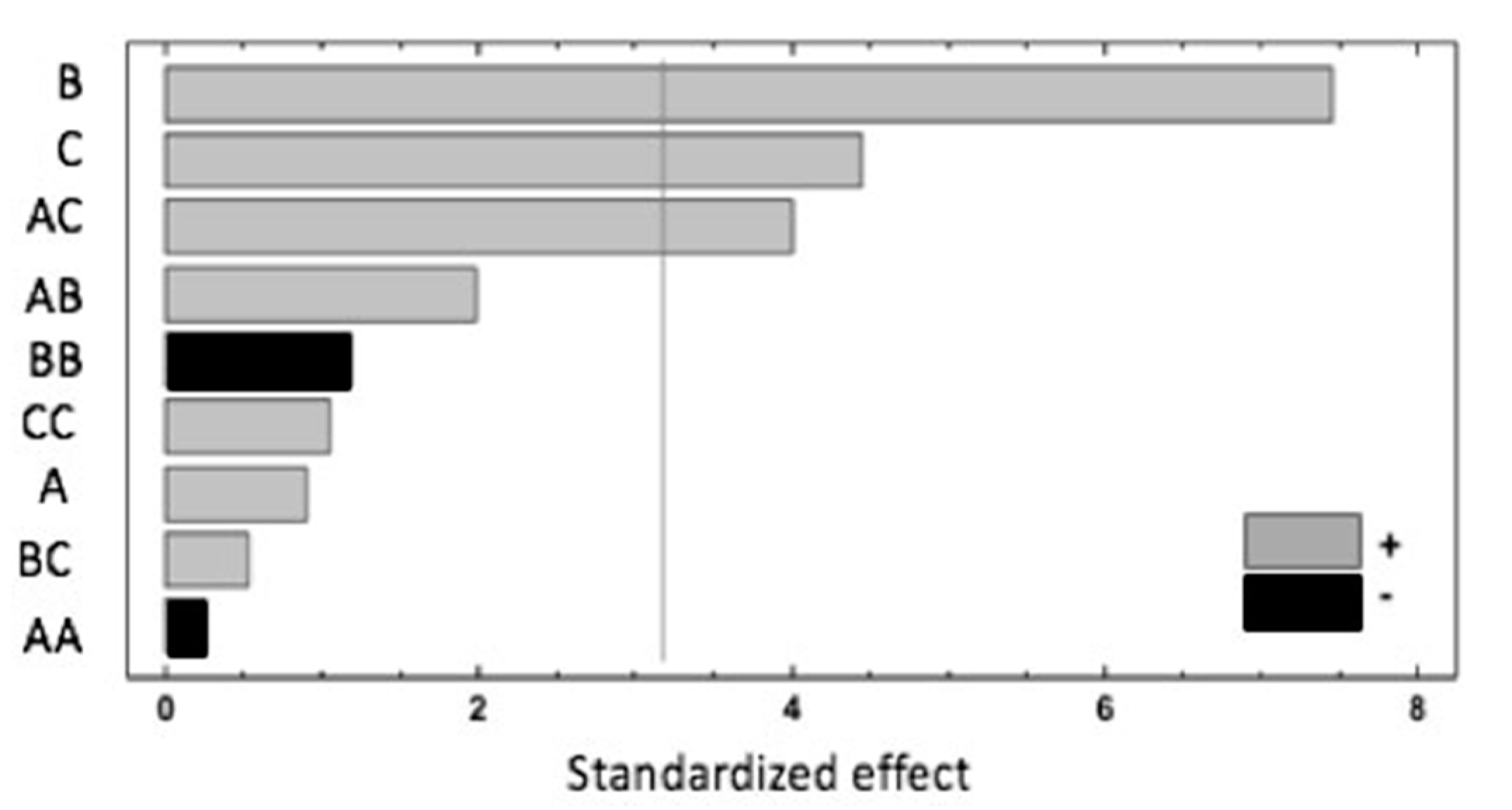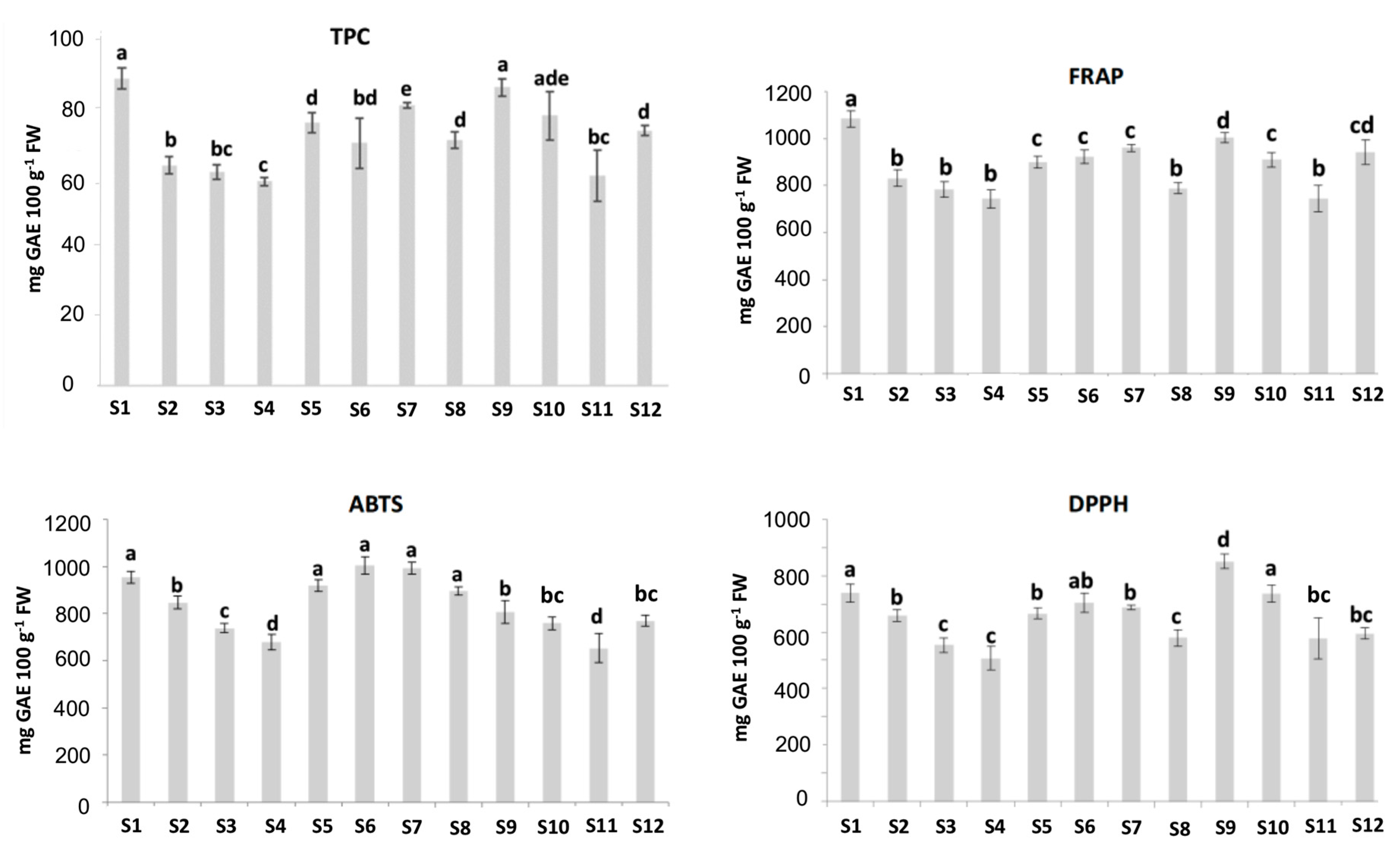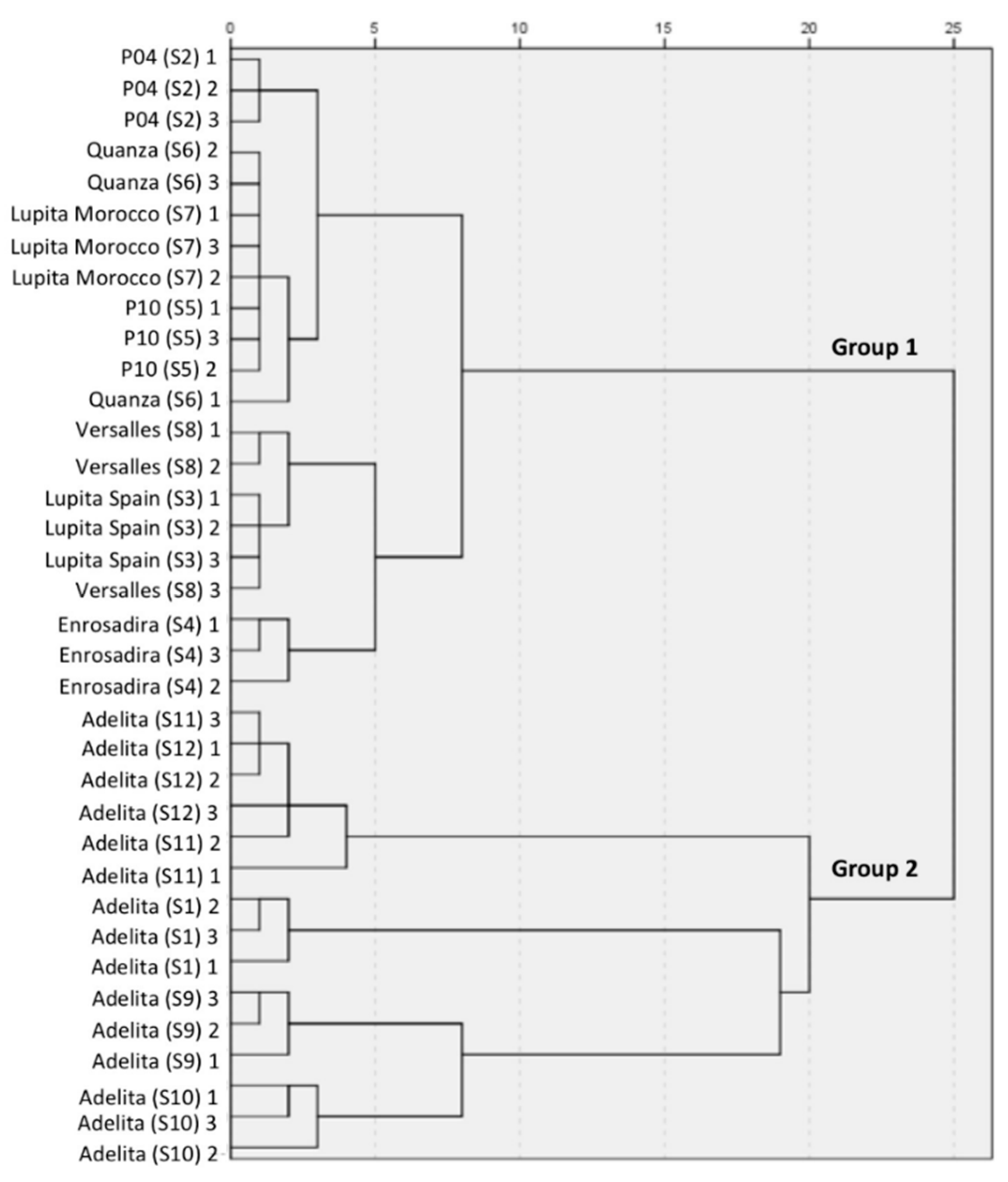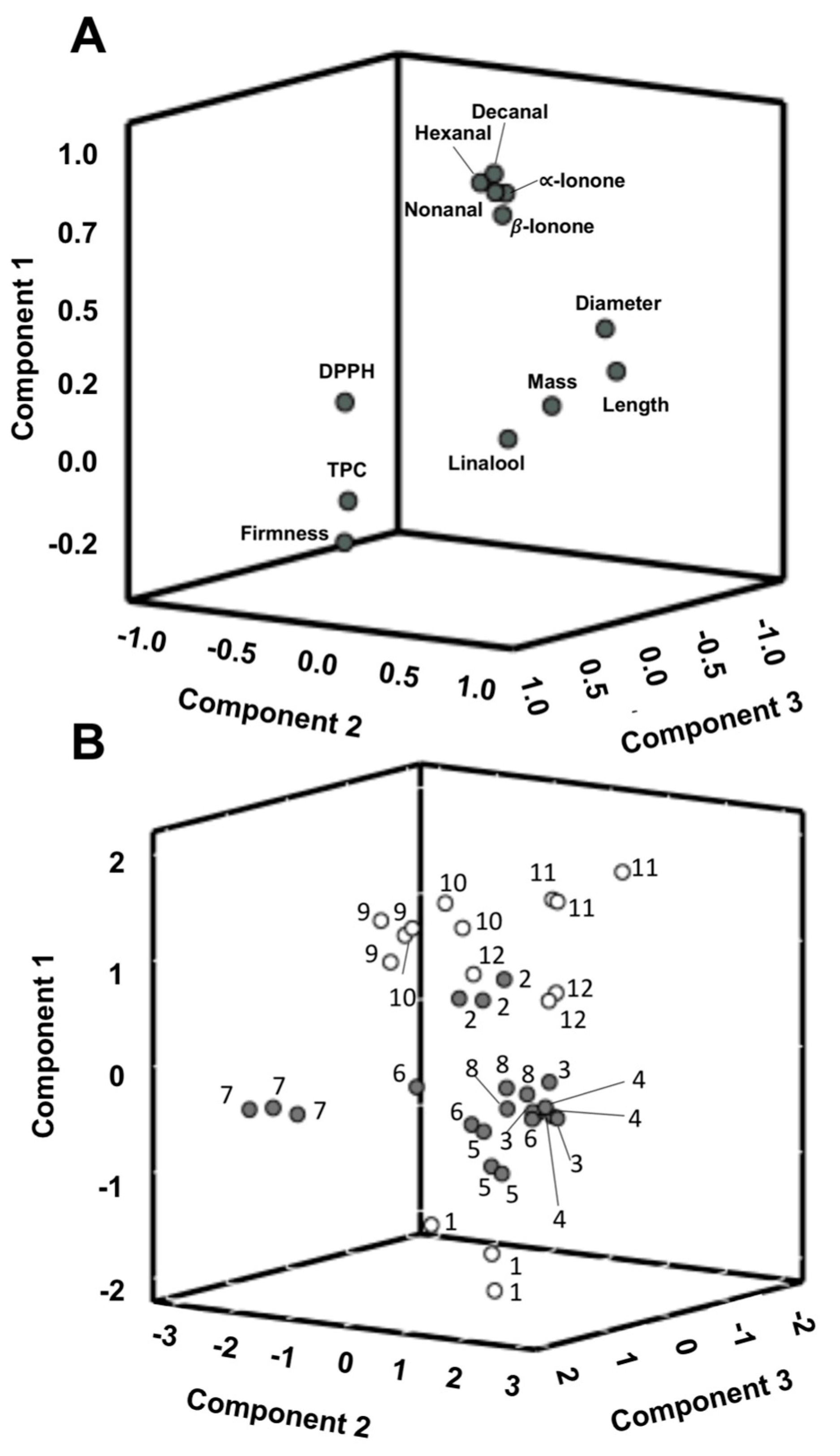Authentication of “Adelita” Raspberry Cultivar Based on Physical Properties, Antioxidant Activity and Volatile Profile
Abstract
1. Introduction
2. Materials and Methods
2.1. Reagents
2.2. Samples
2.3. Physical Measurements of Samples
2.4. Analysis of Volatile Compounds by HS-SPME-GC-MS
2.4.1. HS-SPME-GC-MS Procedure
2.4.2. Optimisation of HS-SPME Procedure
2.5. Preparation of Antioxidant Extracts
2.6. Total Polyphenols Content (TPC)
2.7. Antioxidant Capacity
2.8. Statistical Analysis
3. Results and Discussion
3.1. Physical Analysis of Raspberry Cultivars
3.2. Optimisation of HS-SPME Procedure by BBD
3.3. Validation of HS-SPME-GC-MS Method
3.4. Quantification of Target Volatile Compounds of Raspberry Cultivars
3.5. Analysis of Total Polyphenol Content (TPC)
3.6. Antioxidant Capacity: DPPH, ABTS and FRAP Results
3.7. Correlation between TPC and Antioxidant Methods
3.8. “Adelita” Raspberry Cultivar Classification by Multivariate Analysis
4. Conclusions
Supplementary Materials
Author Contributions
Funding
Acknowledgments
Conflicts of Interest
References
- FAOSTAT Statistics Database-Food and Agriculture Organization of the United Nations. Available online: http://www.fao.org/faostat/en/#data (accessed on 15 January 2020).
- Døving, A.; Måge, F. Methods of testing strawberry fruit firmness. Acta Agric. Scand. B Soil Plant Sci. 2002, 52, 43–51. [Google Scholar] [CrossRef]
- Ponder, A.; Hallman, E. The effects of organic and conventional farm management and harvest time on the polyphenol content in different raspberry cultivars. Food Chem. 2019, 301, 125295. [Google Scholar] [CrossRef] [PubMed]
- Aprea, E.; Biasioli, F.; Carlin, S.; Endrizzi, I.; Gasperi, F. Investigation of volatile compounds in two raspberry cultivars by two headspace techniques: Solid-phase microextraction/gas chromatography-mass spectrometry (SPME/GC-MS) and proton-transfer reaction-mass spectrometry (PTR-MS). J. Agric. Food Chem. 2009, 57, 4011–4018. [Google Scholar] [CrossRef] [PubMed]
- Clarke, H.J.; Mannion, D.T.; O’Sullivan, M.G.; Kerry, J.P.; Kilcawley, K.N. Development of a headspace solid-phase microextraction gas chromatography-mass spectrometry method for the quantification of volatiles associated with lipid oxidation in whole milk powder using response surface methodology. Food Chem. 2019, 292, 75–80. [Google Scholar] [CrossRef] [PubMed]
- D’Agostino, M.F.; Sanz, J.; Sanz, M.L.; Giuffrè, A.M.; Sicari, V.; Soria, A.C. Optimization of a Solid-Phase Microextraction method for the Gas Chromatography-Mass Spectrometry Analysis of blackberry (Rubus ulmifolius Schott) fruit volatiles. Food Chem. 2015, 178, 10–17. [Google Scholar] [CrossRef] [PubMed]
- Cantín, C.M.; Minas, I.S.; Goulas, V.; Jiménez, M.; Manganaris, G.A.; Michailides, T.J.; Crisosto, C.H. Sulfur dioxide fumigation alone or in combination with CO2 -enriched atmosphere extends the market life of highbush blueberry fruit. Postharvest Biol. Technol. 2012, 67, 84–91. [Google Scholar] [CrossRef]
- Pierron-Darbonne, A. Raspberry plant named “Adelita”. Plantas de Navarra S.A. (Valtierra, Navarra, Spain): 2012. Available online: https://patents.google.com/patent/US20120311748P1/en (accessed on 15 July 2012).
- Stavang, J.A.; Freitag, S.; Foito, A.; Verrall, S.; Heide, O.M.; Stewart, D.; Sønsteby, A. Raspberry fruit quality changes during ripening and storage as assessed by colour, sensory evaluation and chemical analyses. Sci. Hortic. 2015, 195, 216–225. [Google Scholar] [CrossRef]
- Jara-Palacios, M.J.; Santisteban, A.; Gordillo, B.; Hernanz, D.; Heredia, F.J.; Escudero-Gilete, M.L. Comparative study of red berry pomaces (blueberry, red raspberry, red currant and blackberry) as source of antioxidants and pigments. Eur. Food Res. Technol. 2019, 245, 1–9. [Google Scholar] [CrossRef]
- Beltrán, A.; De Pablo, S.; Maestre, S.; García, A.; Prats, S. Influence of cooking and ingredients on the antioxidant activity, phenolic content and volatile profile of different variants of the Mediterranean typical tomato Sofrito. Antioxidants 2019, 8, 551. [Google Scholar] [CrossRef]
- Mieres-Castro, D.; Schmeda-Hirschmann, G.; Theoduloz, C.; Gómez-Alonso, S.; Pérez-Navarro, J.; Márquez, K.; Jiménez-Aspee, F. Antioxidant activity and the isolation of polyphenols and new iridoids from Chilean Gaultheria phillyreifolia and G. poeppigii berries. Food Chem. 2019, 291, 167–179. [Google Scholar] [CrossRef]
- Pérez-Jiménez, J.; Arranz, S.; Tabernero, M.; Díaz- Rubio, M.E.; Serrano, J.; Goñi, I.; Saura-Calixto, F. Updated methodology to determine antioxidant capacity in plant foods, oils and beverages: Extraction, measurement and expression of results. Food Res. Int. 2008, 41, 274–285. [Google Scholar] [CrossRef]
- Gramza-Michałowska, A.; Bueschke, M.; Kulczyński, B. Phenolic compounds and multivariate analysis of antiradical properties of red fruits. Food Measure. 2019, 13, 1739–1747. [Google Scholar] [CrossRef]
- Masci, A.; Coccia, A.; Lendaro, E.; Mosca, L.; Paolicelli, P.; Cesa, S. Evaluation of different extraction methods from pomegranate whole fruit or peels and the antioxidant and antiproliferative activity of the polyphenolic fraction. Food Chem. 2016, 202, 59–69. [Google Scholar] [CrossRef] [PubMed]
- Benzie, I.F.F.; Strain, J.J. The ferric reducing ability of plasma (FRAP) as a measure of “antioxidant power”:The FRAP assay. Anal. Biochem. 1996, 239, 70–76. [Google Scholar] [CrossRef]
- García-Gago, J.A.; López-Aranda, J.M.; Muñoz-Blanco, J.; Toro, F.J.; Quesada, M.A.; Pliego-Alfaro, F.; Mercado, J.A. Postharvest behaviour of transgenic strawberry with polygalacturonase or pectate lyase genes silenced. Acta Hortic. 2009, 842, 573–576. [Google Scholar] [CrossRef]
- Aprea, E.; Carlin, S.; Giongo, L.; Grisenti, M.; Gasperi, F. Characterization of 14 Raspberry Cultivars by Solid-Phase Microextraction and Relationship with Gray Mold Susceptibility. J. Agric. Food Chem. 2010, 58, 1100–1105. [Google Scholar] [CrossRef]
- Pawliszyn, J. Theory of Solid-Phase Microextraction. Handb. Solid Phase Microextraction 2012, 38, 13–59. [Google Scholar] [CrossRef]
- Giuggioli, N.R.; Briano, R.; Baudino, C.; Peano, C. Effects of packaging and storage conditions on quality and volatile compounds of raspberry fruits. CYTA J. Food 2015, 13, 512–521. [Google Scholar] [CrossRef]
- Malowicki, S.M.M.; Martin, R.; Qian, M.C. Volatile composition in raspberry cultivars grown in the pacific northwest determined by stir bar sorptive extraction-gas chromatography-mass spectrometry. J. Agric. Food Chem. 2008, 56, 4128–4133. [Google Scholar] [CrossRef]
- Morales, M.L.; Callejón, R.M.; Ubeda, C.; Guerreiro, A.; Gago, C.; Miguel, M.G.; Antunes, M.D. Effect of storage time at low temperature on the volatile compound composition of Sevillana and Maravilla raspberries. Postharvest Biol. Technol. 2014, 96, 128–134. [Google Scholar] [CrossRef]
- Teegarden, M.D.; Schwartz, S.J.; Cooperstone, J.L. Profiling the impact of thermal processing on black raspberry phytochemicals using untargeted metabolomics. Food Chem. 2019, 274, 782–788. [Google Scholar] [CrossRef] [PubMed]
- Paterson, A.; Kassim, A.; McCallum, S.; Woodhead, M.N.; Smith, K.; Zait, D.; Graham, J. Environmental and seasonal influences on red raspberry flavour volatiles and identification of quantitative trait loci (QTL) and candidate genes. Theor. Appl. Genet. 2012, 126, 33–48. [Google Scholar] [CrossRef] [PubMed]
- Aaby, K.; Skaret, J.; Røen, D.; Sønsteby, A. Sensory and instrumental analysis of eight genotypes of red raspberry (Rubus idaeus L.) fruits. J. Berry Res. 2019, 9, 483–498. [Google Scholar] [CrossRef]
- Tabet, Z.A.; Dib, M.E.A.; Djabou, N.; Ilias, F.; Costa, J.; Muselli, A. Antifungal activities of essential oils and hydrosol extracts of Daucus carota subsp. sativus for the control of fungal pathogens, in particular gray rot of strawberry during storage. J. Essential Oil Res. 2017, 29, 391–399. [Google Scholar] [CrossRef]
- Shi, K.; Liu, Z.; Wang, J.; Zhu, S.; Huang, D. Nitric oxide modulates sugar metabolism and maintains the quality of red raspberry during storage. Sci. Hortic. 2019, 256, 108611. [Google Scholar] [CrossRef]
- Milivojević, J.; Rakonjac, V.; Akšić, M.F.; Pristov, J.B.; Maksimović, V. Classification and fingerprinting of different berries based on biochemical profiling and antioxidant capacity. Pesqui. Agropecu. Bras. 2013, 48, 1285–1294. [Google Scholar] [CrossRef]
- Yang, J.; Cui, J.; Chen, J.; Yao, J.; Hao, Y.; Fan, Y.; Liu, Y. Evaluation of physicochemical properties in three raspberries (Rubus idaeus) at five ripening stages in northern China. Sci. Hortic. 2020, 263, 109146. [Google Scholar] [CrossRef]
- Auzanneau, N.; Weber, P.; Kosińska-Cagnazzo, A.; Andlauer, W. Bioactive compounds and antioxidant capacity of Lonicera caerulea berries: Comparison of seven cultivars over three harvesting years. J. Food Compost. Anal. 2018, 66, 81–89. [Google Scholar] [CrossRef]
- Obeng, E.; Kpodo, F.M.; Tettey, C.O.; Essuman, E.K.; Adzinyo, O.A. Antioxidant, total phenols and proximate constituents of four tropical leafy vegetables. Sci. Afr. 2020, 7, e00227. [Google Scholar] [CrossRef]
- Floegel, A.; Kim, D.O.; Chung, S.J.; Koo, S.I.; Chun, O.K. Comparison of ABTS/DPPH assays to measure antioxidant capacity in popular antioxidant-rich US foods. J. Food Comp. Anal. 2011, 24, 1043–1048. [Google Scholar] [CrossRef]
- Wootton-Beard, P.C.; Moran, A.; Ryan, L. Stability of the total antioxidant capacity and total polyphenol content of 23 commercially available vegetable juices before and after in vitro digestion measured by FRAP, DPPH, ABTS and Folin-Ciocalteu methods. Food Res. Int. 2011, 44, 217–224. [Google Scholar] [CrossRef]
- Dudonné, S.; Vitrac, X.; Coutiére, P.; Woillez, M.; Mérillon, J.-M. Comparative study of antioxidant properties and total phenolic content of 30 plant extracts of industrial interest using DPPH, ABTS, FRAP, SOD, and ORAC assays. J. Agric. Food Chem. 2009, 57, 1768–1774. [Google Scholar] [CrossRef] [PubMed]





| Run | Sample Weight (g) | Extraction Temperature (°C) | Extraction Time (min) |
|---|---|---|---|
| 1 | 2.0 | 60 | 27.5 |
| 2 | 1.25 | 60 | 45 |
| 3 | 0.5 | 47.5 | 10 |
| 4 | 1.25 | 35 | 45 |
| 5 | 1.25 | 35 | 10 |
| 6 | 1.25 | 47.5 | 27.5 |
| 7 | 2.0 | 47.5 | 10 |
| 8 | 1.25 | 47.5 | 27.5 |
| 9 | 0.5 | 35 | 27.5 |
| 10 | 1.25 | 60 | 10 |
| 11 | 2.0 | 35 | 27.5 |
| 12 | 0.5 | 60 | 27.5 |
| 13 | 1.25 | 47.5 | 27.5 |
| 14 | 1.25 | 47.5 | 27.5 |
| 15 | 2.0 | 47.5 | 45 |
| 16 | 0.5 | 47.5 | 45 |
| Sample | Mass (g) | Length (cm) | Diameter (cm) | Firmness (N) |
|---|---|---|---|---|
| S1 | 7.08 ± 0.15 a | 2.8 ± 0.1 a | 2.7 ± 0.1 a | 4.1 ± 0.2 a |
| S2 | 6.47 ± 0.08 b | 2.6 ± 0.1 ab | 2.6 ± 0.2 ab | 4.1 ± 0.3 a |
| S3 | 5.31 ± 0.19 c | 2.5 ± 0.1 b | 2.7 ± 0.1 a | 3.5 ± 0.2 b |
| S4 | 5.35 ± 0.17 c | 2.7 ± 0.1 b | 2.6 ± 0.2 ab | 4.6 ± 0.3 a |
| S5 | 6.85 ± 0.10 b | 2.6 ± 0.1 b | 2.6 ± 0.1 b | 3.3 ± 0.1 c |
| S6 | 6.53 ± 0.18 b | 2.5 ± 0.1 b | 2.6 ± 0.1 ab | 3.5 ± 0.1 bc |
| S7 | 4.9 ± 0.3 d | 2.1 ± 0.2 c | 2.2 ± 0.1 c | 5.3 ± 0.2 d |
| S8 | 5.45 ± 0.07 c | 2.5 ± 0.1 b | 2.9 ± 0.2 a | 4.0 ± 0.1 a |
| S9 | 6.6 ± 0.4 ab | 2.7 ± 0.1 a | 2.8 ± 0.1 a | 3.5 ± 0.1 b |
| S10 | 6.61 ± 0.19 ab | 2.7 ± 0.1 a | 2.8 ± 0.1 a | 3.4 ± 0.2 b |
| S11 | 6.9 ± 0.2 ab | 2.8 ± 0.1 a | 2.9 ± 0.1 a | 3.5 ± 0.2 b |
| S12 | 6.6 ± 0.3 ab | 2.8 ± 0.2 a | 2.8 ± 0.1 a | 3.7 ± 0.3 ab |
| Sample | Hexanal | Linalool | Nonanal | Decanal | α-Ionone | β-Ionone |
|---|---|---|---|---|---|---|
| S1 | 0.8 ± 0.1 a | 260 ± 19 a | 56 ± 9 a | 8 ± 2 a | 41.5 ± 0.4 a | 212 ± 20 a |
| S2 | 10.4 ± 1.2 b | 22 ± 2 b | 74 ± 4 b | 27 ± 6 b | 73 ± 5 b | 210 ± 5 a |
| S3 | 5.7 ± 0.9 c | 16.85 ± 0.20 b | 48 ± 4 a | 6.3 ± 0.6 a | 40 ± 2 a | 134 ± 6 b |
| S4 | 1.1 ± 0.3 a | 14.21 ± 0.10 b | 48 ± 5 a | 3.3 ± 0.8 c | 45 ± 6 a | 227 ± 26 ab |
| S5 | 1.4 ± 0.5 a | 22.8 ± 0.8 b | 48 ± 3 a | 12 ± 2 a | 58.4 ± 0.3 c | 138 ± 19 b |
| S6 | 4.6 ± 1.6 ce | 16.6 ± 1.7 b | 72 ± 3 b | 17 ± 2 d | 38.1 ± 1.5 d | 130 ± 11 b |
| S7 | 1.4 ± 0.2 a | 42.9 ± 1.4 c | 44 ± 5 a | 4.6 ± 0.8 a | 39.8 ± 1.2 a | 141 ± 10 b |
| S8 | 4.7 ± 0.7 c | 43 ± 4 c | 55 ± 5 ac | 22 ± 3 b | 42 ± 2 a | 140 ± 18 b |
| S9 | 14 ± 4 bd | 86 ± 7 d | 102 ± 4 d | 57.8 ± 0.5 e | 66 ± 7 bc | 360 ± 17 c |
| S10 | 15 ± 4 bd | 120 ± 11 de | 92 ± 4 d | 58.3 ± 1.2 e | 90 ± 8 be | 310 ± 22 c |
| S11 | 16.5 ± 1.8 d | 154 ± 9 e | 97 ± 3 d | 61.7 ± 0.4 f | 92.8 ± 1.4 e | 360 ± 18 c |
| S12 | 3.4 ± 0.4 e | 169 ± 13 e | 100 ± 6 d | 61.0 ± 0.8 ef | 90.4 ± 1.6 e | 351 ± 12 c |
© 2020 by the authors. Licensee MDPI, Basel, Switzerland. This article is an open access article distributed under the terms and conditions of the Creative Commons Attribution (CC BY) license (http://creativecommons.org/licenses/by/4.0/).
Share and Cite
Valdés García, A.; Maestre Pérez, S.E.; Butsko, M.; Prats Moya, M.S.; Beltrán Sanahuja, A. Authentication of “Adelita” Raspberry Cultivar Based on Physical Properties, Antioxidant Activity and Volatile Profile. Antioxidants 2020, 9, 593. https://doi.org/10.3390/antiox9070593
Valdés García A, Maestre Pérez SE, Butsko M, Prats Moya MS, Beltrán Sanahuja A. Authentication of “Adelita” Raspberry Cultivar Based on Physical Properties, Antioxidant Activity and Volatile Profile. Antioxidants. 2020; 9(7):593. https://doi.org/10.3390/antiox9070593
Chicago/Turabian StyleValdés García, Arantzazu, Salvador E. Maestre Pérez, Mikita Butsko, María Soledad Prats Moya, and Ana Beltrán Sanahuja. 2020. "Authentication of “Adelita” Raspberry Cultivar Based on Physical Properties, Antioxidant Activity and Volatile Profile" Antioxidants 9, no. 7: 593. https://doi.org/10.3390/antiox9070593
APA StyleValdés García, A., Maestre Pérez, S. E., Butsko, M., Prats Moya, M. S., & Beltrán Sanahuja, A. (2020). Authentication of “Adelita” Raspberry Cultivar Based on Physical Properties, Antioxidant Activity and Volatile Profile. Antioxidants, 9(7), 593. https://doi.org/10.3390/antiox9070593










